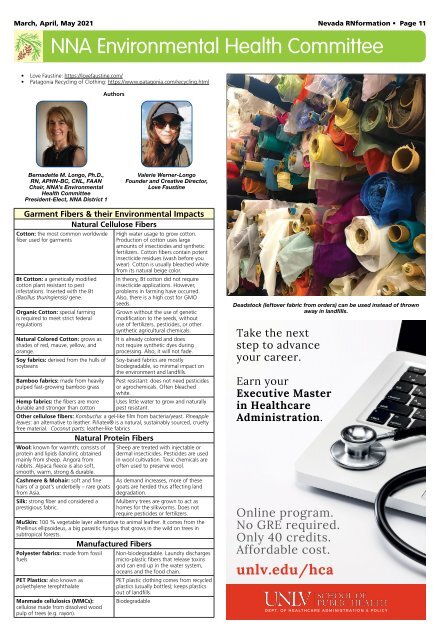Nevada RNformation - March 2011
You also want an ePaper? Increase the reach of your titles
YUMPU automatically turns print PDFs into web optimized ePapers that Google loves.
<strong>March</strong>, April, May 2021 <strong>Nevada</strong> <strong>RNformation</strong> • Page 11<br />
NNA Environmental Health Committee<br />
• Love Faustine: https://lovefaustine.com/<br />
• Patagonia Recycling of Clothing: https://www.patagonia.com/recycling.html<br />
Authors<br />
Bernadette M. Longo, Ph.D.,<br />
RN, APHN-BC, CNL, FAAN<br />
Chair, NNA’s Environmental<br />
Health Committee<br />
President-Elect, NNA District 1<br />
Valerie Werner-Longo<br />
Founder and Creative Director,<br />
Love Faustine<br />
Garment Fibers & their Environmental Impacts<br />
Natural Cellulose Fibers<br />
Cotton: the most common worldwide<br />
fiber used for garments<br />
Bt Cotton: a genetically modified<br />
cotton plant resistant to pest<br />
infestations. Inserted with the Bt<br />
(Bacillus thuringiensis) gene.<br />
Organic Cotton: special farming<br />
is required to meet strict federal<br />
regulations<br />
Natural Colored Cotton: grows as<br />
shades of red, mauve, yellow, and<br />
orange.<br />
Soy fabrics: derived from the hulls of<br />
soybeans<br />
Bamboo fabrics: made from heavily<br />
pulped fast-growing bamboo grass<br />
Hemp fabrics: the fibers are more<br />
durable and stronger than cotton<br />
High water usage to grow cotton.<br />
Production of cotton uses large<br />
amounts of insecticides and synthetic<br />
fertilizers. Cotton fibers contain potent<br />
insecticide residues (wash before you<br />
wear). Cotton is usually bleached white<br />
from its natural beige color.<br />
In theory, Bt cotton did not require<br />
insecticide applications. However,<br />
problems in farming have occurred.<br />
Also, there is a high cost for GMO<br />
seeds.<br />
Grown without the use of genetic<br />
modification to the seeds, without<br />
use of fertilizers, pesticides, or other<br />
synthetic agricultural chemicals.<br />
It is already colored and does<br />
not require synthetic dyes during<br />
processing. Also, it will not fade.<br />
Soy-based fabrics are mostly<br />
biodegradable, so minimal impact on<br />
the environment and landfills.<br />
Pest resistant: does not need pesticides<br />
or agrochemicals. Often bleached<br />
white.<br />
Uses little water to grow and naturally<br />
pest resistant.<br />
Other cellulose fibers: Kombucha: a gel-like film from bacteria/yeast. Pineapple<br />
leaves: an alternative to leather. Piñatex® is a natural, sustainably sourced, cruelty<br />
free material. Coconut parts: leather-like fabrics<br />
Natural Protein Fibers<br />
Wool: known for warmth; consists of<br />
protein and lipids (lanolin); obtained<br />
mainly from sheep. Angora from<br />
rabbits. Alpaca fleece is also soft,<br />
smooth, warm, strong & durable.<br />
Cashmere & Mohair: soft and fine<br />
hairs of a goat's underbelly – rare goats<br />
from Asia.<br />
Silk: strong fiber and considered a<br />
prestigious fabric.<br />
Sheep are treated with injectable or<br />
dermal insecticides. Pesticides are used<br />
in wool cultivation. Toxic chemicals are<br />
often used to preserve wool.<br />
As demand increases, more of these<br />
goats are herded thus affecting land<br />
degradation.<br />
Mulberry trees are grown to act as<br />
homes for the silkworms. Does not<br />
require pesticides or fertilizers.<br />
MuSkin: 100 % vegetable layer alternative to animal leather. It comes from the<br />
Phellinus ellipsoideus, a big parasitic fungus that grows in the wild on trees in<br />
subtropical forests.<br />
Manufactured Fibers<br />
Polyester fabrics: made from fossil<br />
fuels<br />
PET Plastics: also known as<br />
polyethylene terephthalate<br />
Manmade cellulosics (MMCs):<br />
cellulose made from dissolved wood<br />
pulp of trees (e.g. rayon).<br />
Non-biodegradable. Laundry discharges<br />
micro-plastic fibers that release toxins<br />
and can end up in the water system,<br />
oceans and the food chain.<br />
PET plastic clothing comes from recycled<br />
plastics (usually bottles); keeps plastics<br />
out of landfills.<br />
Biodegradable<br />
Deadstock (leftover fabric from orders) can be used instead of thrown<br />
away in landfills.

















